| Mahavira Jain temple | |
|---|---|
 Mahavira Jain Temple in 1897 | |
| Religion | |
| Affiliation | Jainism |
| Deity | Mahavira |
| Festivals | Mahavir Janma Kalyanak |
| Governing body | Seth Shri Mangalsinghji Ratansinghji Dev ki Pedhi |
| Location | |
| Location | Osian, Jodhpur, Rajasthan |
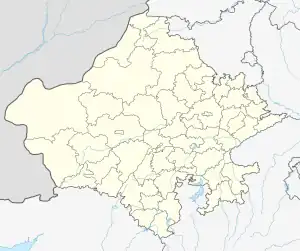 Location of Mahavira Derasar in Rajasthan | |
| Geographic coordinates | 26°43′28.4″N 72°53′30.4″E / 26.724556°N 72.891778°E |
| Architecture | |
| Style | Gurjara-Pratihara |
| Date established | 783 A.D. |
| Temple(s) | 1 |
The Mahavira Jain temple is built in Osian of Jodhpur District, Rajasthan. The temple is an important pilgrimage of the Oswal Jain community. This temple is the oldest surviving Jain temple in Western India and was built during the reign of Mahārāja Śrī Vatsarāja of Imperial Pratihāras.[1] The temple is visited by both Jain and Hindu.
History
The Mahavira Temple is an important tirtha for Jains. According to an inscription found at Sachiya Mata Temple dating back to 956 A.D., it was built during the Gurjara-Pratihara dynasty by King Vatsaraja in 783 AD,[2][3][4] making it the oldest surviving Jain temple in Western India.[5] According to Jain legends, Acharya Ratnaprabhasuri in (c. 457 BCE) restored the life of son of a prominent brahman following this even the villagers converted to Jainism and this place for origination of Oswal community.[6][7] Witnessing the power of Ratnaprabhasuri Goddess Chamunda was compelled to become a Jain vegetarian deity[6][8] and became the protector deity of the temple, protecting devotees who worship image of Mahavira in the temple.[9] Ratnaprabhasuri then named her Sachiya Mata as she truthfully advised Ratnaprabhasuri to stay in Osian during Chaturmas.[10] The idol of Mahavira was discovered from buried at temple site.[6]
An inscription dating 953 CE found in the temple states that Osian was rich with decorated temples of every caste.[2] The temple had its first renovation in 956 AD.[11][12] George Michell describes the existing main temple as "mostly 11th century", with parts from the 8th century. The torana (ornate gateway) is from 1015 CE.[13][14] The temple was plundered by Muslim rulers, and none of the original idols survived. In 1016 CE, the temple was restored, and a manastambha was constructed.[15] The temple was later renovated in the 12th century.[16]
Architecture
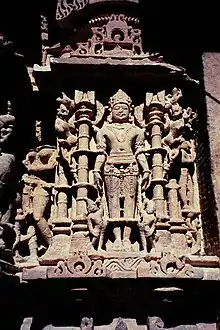
The Jain temple is dedicated to Mahavira and belongs to Śvētāmbara sect of Jainism. The temple is considered a testimony of architecture Gurjara-Pratihara dynasty.[17] This a large temple[18] surrounded by enclosing wall consisting of garbhagriha, mandapa. The temple features a sanctum, a closed hall, an open porch and an ornate Torana (gateway) and exquisite sculptures.[19][20] The temple has one closed and two pillared halls elongated the axis of principal shrine.[21] The torana in front of the sanctum is rich with ornate carvings of tirthankaras, 12 in padmasan posture and 4 kayotsarga positions.[22] The pillars of the temple feature intricate artwork are particular Maha-Maru tradition.[19][23] The temple has seven subsidiaries, four on the eastern and three of the western side of the sanctum.[24] These shrines are joined by pradaksinapatha. Eastern parts of the shrine have figures of Mahavira and Parshavanatha.[18] The Shikhara of the garbhagriha and subsidiary shrine are crowned with amalaka and kalasa.[14] The shikhara above mulprasad was constructed later with Māru-Gurjara architecture.[22]
The temple has a large image of Mahavira covered with 400 grams (14 oz) of gold is placed inside the garbhagriha.[25] The outer and inner walls of the sanctum and closed hall are profusely decorated with carvings of Asta-Dikpalas, yaksha—yakshi, tirthankara, vidyadevi, and other deities. Vidyadevi sculptures are portrayed as playing musical instruments. The northern, southern, western walls of the temple have carvings of Neminatha's life like birth, war, renunciation, etc. The antarala ceiling of every shrine in the temple complex is rich with carvings of flowers.[18] Dev-Kulika temple is also part of the temple complex.[26]
There are three 5.7 feet (1.7 m) Jivantasvami images inside temple. Two of these idols are identical, with one having inscription dated 1044 C.E. that identifies the idol to be of Rishabhanatha.[27] These idols depicts Tirthankara in Kayotsarga posture with ashta-pratiharya (barring lion-throne), yaksha—yakshi, mahavidyas, and miniature Jina figures on patrika.[28]
A Dādābadī housing footprints of Jain monks is also present near the Mahavir temple.[29]
Mahavira temple is one of the most renowned temples in India. The elaborate architecture is comparable to that Parshvanatha temple, Khajuraho and Ranakpur Jain temple.[15]
Gallery
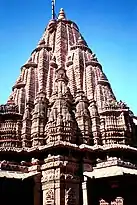 Sikhara of the temple
Sikhara of the temple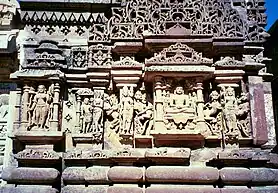 Detailed carving on wall
Detailed carving on wall Temple side view
Temple side view Shikhar
Shikhar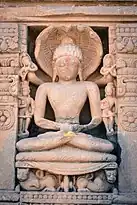 Carving of Parshvanath on wall
Carving of Parshvanath on wall Pillars in Jaina temple Osia in India 1897
Pillars in Jaina temple Osia in India 1897
Conservation
The temple has undergone repairs, renovations, and modifications.[30] The temple is protected by Archaeological Survey of India.[31]
See also
References
Citation
- ↑ "The ancient temples of Osian". Outlook (Indian magazine). Retrieved 24 November 2021.
- 1 2 Kalia 1982, p. 2.
- ↑ Panikar 2010, p. 309.
- ↑ Bose 2015, p. 148.
- ↑ Cort 1998, p. 112.
- 1 2 3 Dundas 2002, p. 149.
- ↑ Hassan 1989, p. 260.
- ↑ Babb 2015, p. 123.
- ↑ Babb 2004, p. 169.
- ↑ Qvarnström 2010, p. 42.
- ↑ Cort 1998, p. 133.
- ↑ Singh 1998, p. 720.
- ↑ Michell 1990, p. 302.
- 1 2 IGNCA, p. 1.
- 1 2 Titze & Bruhn 1998, p. 152.
- ↑ Kalia 1982, p. 3.
- ↑ Singh & Lal 2003, p. 1043.
- 1 2 3 Kalia 1982, p. 4.
- 1 2 Brown 2013, p. 405.
- ↑ Behl 2008.
- ↑ Hegewald 2015, pp. 117–118.
- 1 2 Kalia 1982, p. 5.
- ↑ Neubauer 1981, p. 34.
- ↑ Vasavada 2001.
- ↑ Dobbie 2002, p. 43.
- ↑ Kumar 2001, p. 54.
- ↑ Cort 2010, pp. 163–164.
- ↑ Tiwari 1993, pp. 849–850.
- ↑ Henderson & Weisgrau 2016, p. 282.
- ↑ Kuiper 2010, p. 312.
- ↑ ASI.
Bibliography
Books
- Bose, Melia Belli (25 August 2015). Royal Umbrellas of Stone: Memory, Politics, and Public Identity in Rajput Funerary Art. Brill's Indological Library. New Delhi: Brill Publishers. ISBN 9789004300569.
- Babb, Lawrence A. (10 August 2004). Alchemies of Violence: Myths of Identity and the Life of Trade in Western India. New Delhi: SAGE Publishing. ISBN 9788132103219.
- Babb, Lawrence A. (28 May 2015). Understanding Jainism. Understanding Faith. Dunedin Academic Press. ISBN 9781780465357.
- Brown, Percy (2013) [1942]. Indian Architecture (Buddhist and Hindu Period). Read Books Ltd. ISBN 9781447498575.
- Cort, John E. (1998). Open Boundaries: Jain Communities and Cultures in Indian History. SUNY Press. ISBN 9780791437865.
- Cort, John E. (2010). Framing the Jina: Narratives of Icons and Idols in Jain History. Oxford University Press. ISBN 9780199739578.
- Dobbie, Aline (2002). India: The Peacock's Call. Aline Dobbie's India books. ISBN 9781843940104.
- Dundas, Paul (2002) [1992]. The Jains (Second ed.). London and New York: Routledge. ISBN 978-0-415-26605-5.
- Hassan, Syed Siraj ul (1989). The Castes and Tribes of H.E.H. the Nizam's Dominions. Vol. 1. Asian Educational Services. ISBN 9788120604889.
- Henderson, Carol; Weisgrau, Maxine (23 March 2016). Raj rhapsodies: tourism, heritage and the seduction of history. New Directions in Tourism Analysis. Routledge. ISBN 978-1-3170-7161-7.
- Kalia, Asha (1982). Art of Osian Temples: Socio-economic and Religious Life in India, 8th-12th Centuries A.D. Abhinav Publications. ISBN 9780391025585.
- Kuiper, Kathleen (2010). The Culture of India. Understanding India. Rosen Publishing. ISBN 978-1-61530-149-2.
- Kumar, Sehdev (2001). A Thousand Petalled Lotus: Jain Temples of Rajasthan : Architecture & Iconography. Abhinav Publications. ISBN 9788170173489.
- Michell, George (1990). The Penguin Guide to the Monuments of India: Buddhist, Jain, Hindu. Vol. 1. Penguin Books. ISBN 9780670806966.
- Neubauer, Jutta Jain (1981). The Stepwells of Gujarat: In Art-historical Perspective. Abhinav Publications. ISBN 9780391022843.
- Panikar, Agustin (2010). Jainism: History, Society, Philosophy and Practice. Lala Sunder Lal Jain research series. Vol. 24. Delhi: Motilal Banarsidass. ISBN 978-81-208-3460-6.
- Qvarnström, Olle (2010). Jainism and Early Buddhism: Essays in Honor of Padmanabh S. Jaini. Jain Publishing Company. ISBN 978-0-89581-956-7.
- Titze, Kurt; Bruhn, Klaus (1998). Jainism: A Pictorial Guide to the Religion of Non-Violence (2 ed.). Motilal Banarsidass. ISBN 978-81-208-1534-6.
- Singh, Kumar Suresh; Lal, Rajendra Behari (2003). Gujarat. People of India. Vol. 22. Popular Prakashan. ISBN 978-81-799-1106-8.
- Singh, K.S. (1998). Rajasthan. Anthropological survey of India. Vol. 38. Popular Prakashan. ISBN 978-81-715-4769-2.
Web
- Hegewald, Julia A. B. (2015). "THE INTERNATIONAL JAINA STYLE? Māru-Gurjara Temples Under the Solaṅkīs, throughout India and in the Diaspora". Ars Orientalis. 45 (20220203): 114–140. doi:10.3998/ars.13441566.0045.005. JSTOR 26350210.
- Tiwari, Maruti Nandan (1993). "Jivantasvami images: A study in concept and iconography". Indian History Congress. 54: 847–856. JSTOR 44143087.
- Vasavada, Rabindra (2001). "Temple of Mahavira Osiaji". Lalbhai Dalpatbhai Museum. Monograph Series on Historic Temples. Ahmedabad.
- Behl, Benoy K. (1 August 2008). "Temples of peace". The Hindu.
- ASI. "Protected Monuments in Rajasthan". Archaeological Survey of India. Retrieved 20 July 2021.
- IGNCA. "Mahaveer Jain Mandir" (PDF). Indira Gandhi National Centre for the Arts. Retrieved 8 May 2022.
Further reading
- Vasavada, Rabindra J., Temple of Mahavira Osiaji, 2001, L. D. Institute of Indology, fully online